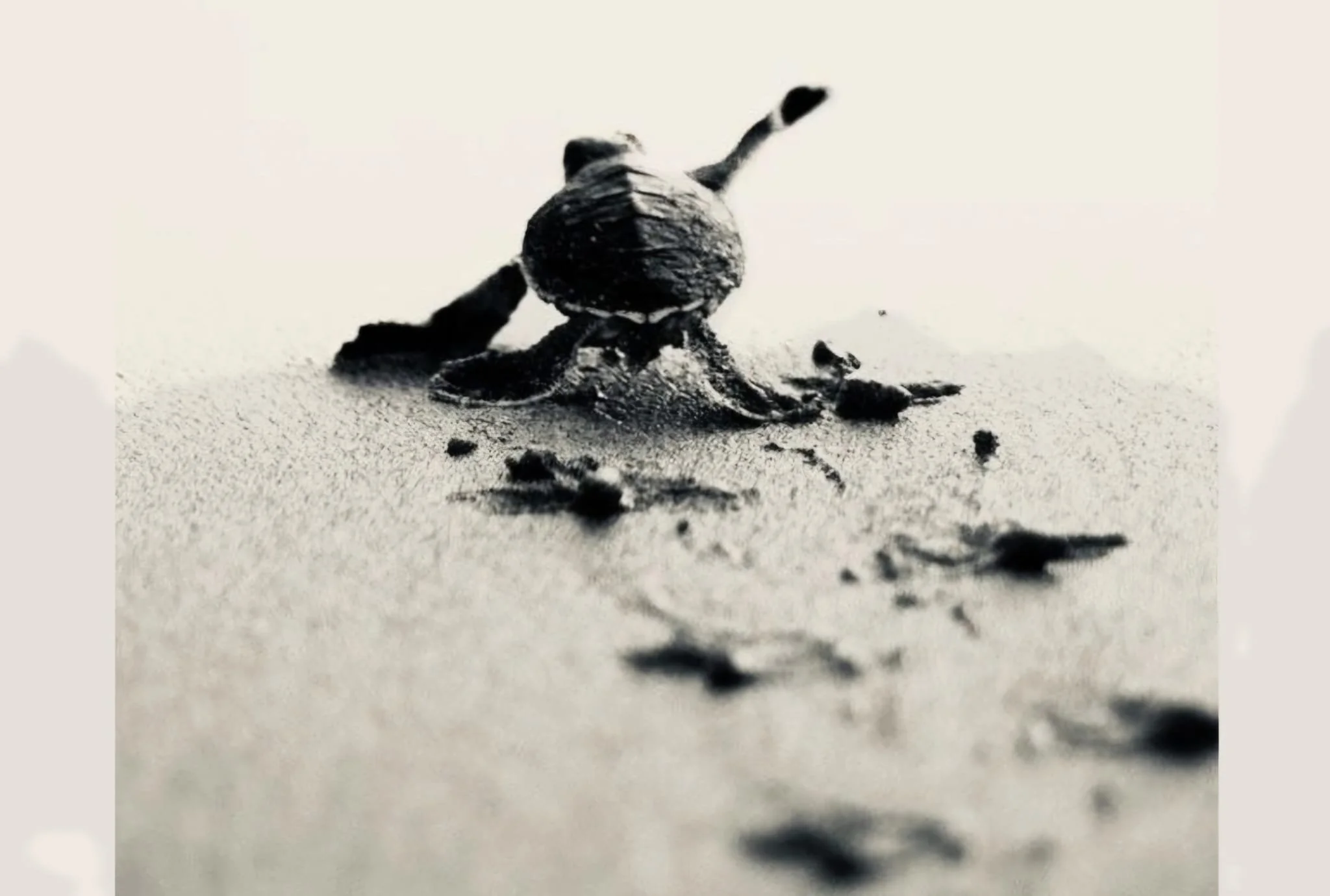Photo by Lisa See
Oceanic -
The story of seaturtles
by Neele Wette
The ocean plays a huge role in fighting climate change. It actually absorbs about 25% of the carbon dioxide that we humans produce. It’s full of amazing life and home to millions of species, with around 80% of them still undiscovered!
One animal most people do know, is the sea turtle. There are seven different kinds, and while they’re all unique, they each help keep the ocean’s ecosystem in balance.
Some sea turtles, for example, eat seagrass, which keeps it short and healthy – kind of like sheep grazing in a field. This is important because seagrass is a home to lots of other sea creatures and it even help store carbon dioxide. Sea turtles also help keep coral reefs healthy and carry important nutrients from the sea to the land, where plants need them. And even though it’s a bit sad, they are also part of the natural food chain.
As you can see, sea turtles play a very important role in our ecosystem. They have lived in our world’s oceans for 150 million years, and now three species are endangered. There are various reasons for this:
Some turtles are misused for medical purposes or killed for religious ceremonies. They are hunted for their meat and their shells. Their eggs are collected before the baby turtles can hatch.
One of the main reasons is that they often end up as bycatch in fishing nets and are either not released or are too badly injured. There are organizations that specialize in rescuing exactly these animals, but due to industrial fishing, there are too many turtles and too few resources to save even close to enough of them.
Another major problem is global warming. Due to warmer waters and the resulting changes in ocean currents, turtles can no longer find their way back to land to lay their eggs. For turtles, it is common to return to the beach where they were born to lay their own eggs. The gender of a sea turtle isn’t determined at birth like in most animals. It is shaped by the warmth of the sand where the eggs are buried. Slightly cooler temperatures produce males, while warmer ones lead to females. But with the planet heating up, more and more females are being born and the natural balance gets disturbed.
But that´s not all, there is also the pollution of the oceans with plastic waste. Only about one in 1,000 turtles reaches the reproductive age of 20 years, and the most common reason for this is microplastics in their bodies. Additionally, young turtles are attracted to the shimmering surface of the water once they are old enough. Increasing light pollution sometimes confuses them in this process and they can´t find the way to the water.
Some problems may be caused by the world’s large industrial corporations, but there are still a few ways each of us can make a small contribution in our everyday lives to help save the sea turtles.
One of the most important steps is to reduce single-use plastics, as anything that ends up in our rivers or lakes can eventually flow into the ocean. Every piece of plastic avoided is a step toward cleaner seas. If you're spending time at the beach, make sure to take all your trash with you and if you see any litter, pick it up. Even small actions can have a big impact on protecting marine life like sea turtles.
And if saving an entire ecosystem isn’t reason enough, then look into their gentle eyes and graceful movements. These ancient, beautiful souls have wandered the oceans for millions of years. We shouldn’t just stand by and watch them disappear forever.
Another major problem is global warming. Due to warmer waters and the resulting changes in ocean currents, turtles can no longer find their way back to land to lay their eggs. For turtles, it is common to return to the beach where they were born to lay their own eggs. The gender of a sea turtle isn’t determined at birth like in most animals. It is shaped by the warmth of the sand where the eggs are buried. Slightly cooler temperatures produce males, while warmer ones lead to females. But with the planet heating up, more and more females are being born and the natural balance gets disturbed.
But that´s not all, there is also the pollution of the oceans with plastic waste. Only about one in 1,000 turtles reaches the reproductive age of 20 years, and the most common reason for this is microplastics in their bodies. Additionally, young turtles are attracted to the shimmering surface of the water once they are old enough. Increasing light pollution sometimes confuses them in this process and they can´t find the way to the water.
Some problems may be caused by the world’s large industrial corporations, but there are still a few ways each of us can make a small contribution in our everyday lives to help save the sea turtles.
One of the most important steps is to reduce single-use plastics, as anything that ends up in our rivers or lakes can eventually flow into the ocean. Every piece of plastic avoided is a step toward cleaner seas. If you're spending time at the beach, make sure to take all your trash with you and if you see any litter, pick it up. Even small actions can have a big impact on protecting marine life like sea turtles.
And if saving an entire ecosystem isn’t reason enough, then look into their gentle eyes and graceful movements. These ancient, beautiful souls have wandered the oceans for millions of years. We shouldn’t just stand by and watch them disappear forever.


